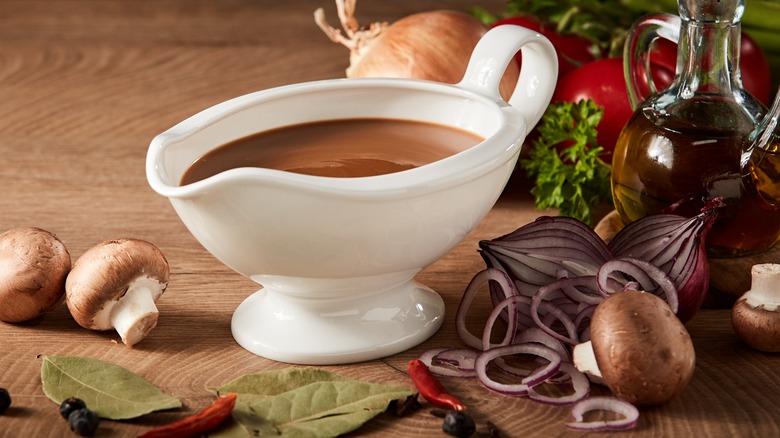The Best Method For Storing And Reheating Your Leftover Gravy Is Also The Easiest
Made too much gravy for one sitting? It happens to the best of us. Luckily, Tasting Table spoke to Freda Sugarman, Executive Chef at Sarabeth's Greenwich Village, and she has some sage words of wisdom for storing and reheating leftover gravy. "No fancy tricks here," she says. "Just cool and cover the gravy. Add a bit of stock and reheat in a pot."
Reheating gravy takes just five to 10 minutes; if you typically make it from scratch, you could be saving yourself more than 20 minutes of prep. It's a handy surplus ingredient to have in the fridge, too. Gravy leftovers are fantastic for creative recipes like pot pies, stuffed potatoes, and even a shepherd's pie with a twist. A simple cool-then-cover strategy is all you need to repurpose the hearty sauce. Adding stock helps to combat any thinning from the separation of essential fats and liquid, thickening the consistency so that it looks and tastes brand new. Of course, maybe you don't have to reheat it at all? If you're storing gravy for someone who's running late for dinner, a thermos is the sure-fire way to keep your gravy warmer for longer.
How long does gravy last in storage?
Looking to keep your perfectly made pot around for longer than 24 hours? It's worth learning how gravy fares in storage. When sealed in an airtight container and refrigerated, three to four days is the golden rule. The freezer keeps it much longer: Frozen gravy lasts anywhere between four and six months. With the proper storing practice, a simple sausage gravy recipe could be the gift that keeps giving.
It's worth noting the difference between gravies. Without the additives that come with formal production, even the tastiest concoction from your kitchen is doomed for an earlier demise. Store-bought versions typically last five to seven days (although always check labels for product-specific guidance). Similarly, if you've utilized some clever ways to make store-bought gravy taste homemade, bear in mind this could accelerate the shelf-life process. Any traces of a sour smell, visible mold, or newly developing watery textures are all red flags and signs that it's time for the bin.
Vegetable gravy may last longer than meat versions — good news for vegetarians. However, quick action will be the main decider of how long your sauce survives. All gravy types expire when left at room temperature for more than two hours; they require savvy cooling and a timely transfer to an airtight container.

